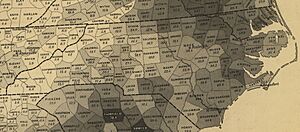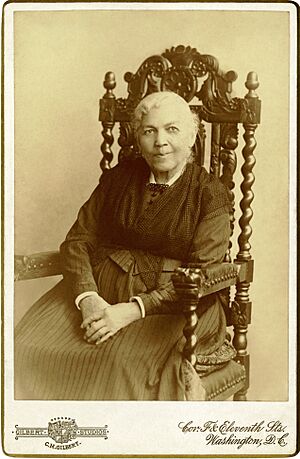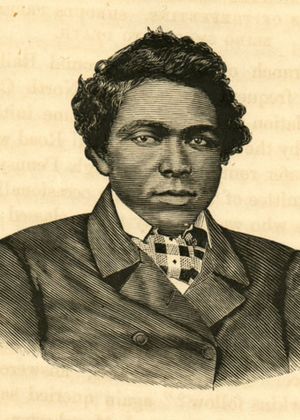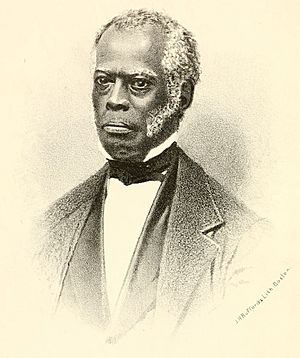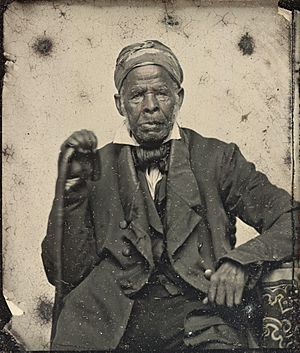History of slavery in North Carolina facts for kids
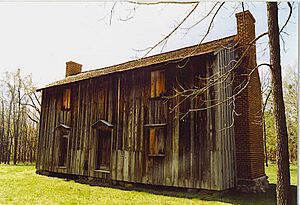
Slavery was a legal practice in North Carolina for a long time. It ended on January 1, 1863, when President Abraham Lincoln issued the Emancipation Proclamation. This important document declared that most enslaved people were free.
Before North Carolina became a state, about 41,000 African Americans were enslaved there in 1767. By 1860, this number grew to 331,059. This meant about one-third of North Carolina's total population was enslaved. In 1860, there were 19 counties in North Carolina where enslaved people outnumbered free white people.
During this time, North Carolina passed many laws. These laws protected the rights of slave owners. They also took away the rights of enslaved people. White slave owners in North Carolina often feared slave revolts. Despite these hard times, some enslaved and freed African Americans became famous. They were known as skilled workers, soldiers, religious leaders, and writers.
Contents
How Slavery Grew in North Carolina
The first owners of the North Carolina colony wanted more enslaved people. They offered land to settlers for each enslaved person they brought. This was called the "headright system."
It was hard to bring enslaved people directly to North Carolina by ship. This was because the state had poor harbors and a dangerous coastline. So, many enslaved people were brought from Virginia or South Carolina. The number of enslaved Black people grew a lot. It went from 800 in 1712 to 6,000 in 1730. By 1767, there were about 41,000 enslaved people.
In the early days, the difference between white workers and African workers was not always clear. Some Africans first came as indentured servants. This meant they worked for a set time to pay off a debt. Later, more Africans were brought as slaves for life. Some Africans were even able to earn their freedom.
Many free people of color families in North Carolina came from mixed-race parents. Often, their mothers were free white women. Their fathers were enslaved or free African men. Since the mothers were free, their children were also born free. These mixed-race families moved to North Carolina's frontier areas.
As fewer indentured servants came from Britain, the colony needed more workers. So, more enslaved people were brought in. Slavery then became a system based on race. The economy of North Carolina grew because of slave labor. Enslaved people were forced to grow crops like tobacco. Life for enslaved people was very difficult and harsh. They sometimes tried to escape, fight back, or steal food to survive.
| Census Year |
1790 | 1800 | 1810 | 1820 | 1830 | 1840 | 1850 | 1860 |
|---|---|---|---|---|---|---|---|---|
| All States, Enslaved People | 694,207 | 887,612 | 1,130,781 | 1,529,012 | 1,987,428 | 2,482,798 | 3,200,600 | 3,950,546 |
| All States, Total Population | 3,893,635 | 5,305,982 | 7,239,881 | 9,638,453 | 12,866,020 | 17,069,453 | 23,191,876 | 31,443,321 |
| North Carolina, Enslaved People | 100,783 | 133,296 | 168,824 | 205,017 | 245,601 | 245,817 | 288,548 | 331,059 |
| North Carolina, Total Population | 393,751 | 478,103 | 555,500 | 638,829 | 737,987 | 753,419 | 869,039 | 992,622 |
| South Carolina, Enslaved People | 107,094 | 146,151 | 196,365 | 251,783 | 315,401 | 327,038 | 384,984 | 402,406 |
| South Carolina, Total Population | 249,073 | 345,591 | 415,115 | 502,741 | 581,185 | 594,398 | 668,507 | 703,708 |
| Tennessee, Enslaved People | – | 13,584 | 44,535 | 80,107 | 141,603 | 183,059 | 239,459 | 275,719 |
| Tennessee, Total Population | – | 105,602 | 261,727 | 422,813 | 681,904 | 829,210 | 1,002,717 | 1,109,801 |
| Virginia, Enslaved People | 292,627 | 346,671 | 392,518 | 425,153 | 469,757 | 449,087 | 472,528 | 490,865 |
| Virginia, Total Population | 691,737 | 807,557 | 877,683 | 938,261 | 1,044,054 | 1,025,227 | 1,119,348 | 1,219,630 |
The number of enslaved people in North Carolina grew a lot. It went from 100,783 in 1790 to 351,059 in 1860. The percentage of enslaved people was different in each county. In 1860, 19 counties had more enslaved people than free white people.
These counties were mostly farming areas. They grew cotton, tobacco, and rice. They also produced naval stores (like tar and pitch). These areas had larger farms and plantations. They were found in the coastal plains, Piedmont, and counties near Virginia. Virginia and South Carolina had even more enslaved people in 1860. The Appalachian mountain counties had fewer enslaved people.
Life for Enslaved People and Owners
Enslaved people were forced to work in many different jobs. Men, women, and children worked as house servants, skilled craftspeople, or field laborers. They worked in cities and on both small farms and large plantations. Plantations were big land areas that grew crops to sell. Some experts say a plantation had many enslaved people. The number could range from ten to over a thousand on very large plantations. In the early 1900s, records showed at least 328 plantations in North Carolina.
Enslaved people were treated as property by their owners. They could be sold whenever the owner wanted. They could also be given to heirs in a will. Records from slave auctions and estates show how much enslaved people were valued. The value depended on their gender and age. Strong enslaved men, especially those with special skills, were valued the most.
During the French and Indian War (1754–1763), an enslaved person was worth about £60 to £80. This value increased to about £180 in 1780. By 1840, it was about $800. At the start of the Civil War, an enslaved male field worker was worth $1,500 to $1,700. An enslaved woman was worth $1,300 to $1,500. A skilled enslaved craftsperson could be valued as high as $2,000.
Laws and Events Affecting Enslaved People
Here are some important laws and events related to enslaved people in North Carolina:
- 1669: Article 10 of the Fundamental Constitutions of Carolina said that every free man had "absolute power" over his enslaved Black people. This was true no matter their beliefs or religion.
- 1739: The Stono Rebellion was a slave uprising in South Carolina. Because it was so close, North Carolina slave owners made laws to stop enslaved people from carrying guns.
- 1741: A North Carolina law made it very hard to free enslaved people. They could only be freed as a reward for great service to the state. If freed, they had to leave North Carolina within six months.
- 1774: The North Carolina Provincial Congress passed a law. It said they would not import or buy any more enslaved people from anywhere in the world.
- 1775–1783: During the American Revolutionary War, Black men from North Carolina fought for both sides.
- 1776: The first Constitution of North Carolina allowed freed enslaved people the right to vote.
- 1791: The Haitian Revolution was a big slave uprising in Haiti. This made North Carolina limit the number of enslaved people brought from the Caribbean.
- 1793: The Fugitive Slave Act of 1793 was a U.S. law. It allowed slave owners to get back enslaved people who had escaped to other states.
- 1808: The United States Congress passed a law. It stopped the international slave trade. This meant no new enslaved people could be brought into the U.S. from other countries.
- 1816: The North Carolina General Assembly passed a law about illegally imported enslaved people. Money from selling these enslaved people went to the state treasury.
- 1816: The North Carolina Manumission Society was formed. This group included Quakers and others who were against slavery.
- 1819: The Panic of 1819 was a time of economic trouble. Many slave owners sold their enslaved people because of money problems. Some farmers moved west to places like Texas Territory for a new start.
- 1835: The North Carolina Constitution was changed. This change took away the right of freed enslaved people to vote.
- 1860: The North Carolina General Assembly had a very high percentage (85%) of politicians who owned enslaved people. This was more than any other state.
- 1863: On January 1, President Abraham Lincoln issued the Emancipation Proclamation. This changed the status of enslaved African Americans in North Carolina and other Confederate States of America from slave to free.
- 1865: Slavery was officially ended by the Thirteenth Amendment to the United States Constitution. This amendment freed about 40,000 remaining enslaved people.
Religions of Enslaved People
The religions among enslaved people were very different. About 20 to 30 percent of enslaved people brought to America were Muslim. Some had heard of Christianity, but many followed traditional African religions.
During the 1700s, most enslaved people kept their native African religions and customs. However, by the early 1800s, many enslaved people started to become Protestant Christians. The most common religions they joined were Baptist and Methodist. Some white churches had special balconies. Enslaved people were allowed to sit there and attend services with their owners. But because of fears of revolts, enslaved people were not allowed to form their own churches until after the Civil War.
Famous Enslaved and Freed People
- John Chavis: He was a free Black educator and Presbyterian minister. Born in Oxford, North Carolina, he fought in the Continental Army during the American Revolutionary War. He was the first African American to graduate from college. He studied at Princeton University and Washington and Lee University. Later, he opened a respected private school in Raleigh, North Carolina, for both white and Black students.
- Thomas Peters: He was enslaved in North Carolina but freed himself. He joined the British forces during the American Revolution. He was a Black Loyalist and was taken to New York with other former slaves. Thomas Peters is called the "first African-American hero." He helped found the nation of Sierra Leone, like Elijah Johnson and Joseph Jenkins Roberts did for Liberia.
- Jonathan Overton: He was a Black soldier from North Carolina. He served under George Washington at the Battle of Yorktown.
- Ned Griffin: He was an enslaved man who fought in the American Revolution for his owner. The North Carolina General Assembly freed him and gave him the right to vote, even though his owner did not want him freed.
- Slave James: From Perquimans County, North Carolina, he was a sailor on an American ship during the Revolution. The British captured him twice. After the war, the Perquimans county court freed him.
- George Moses Horton: Known as "the black bard of Chapel Hill," he was the first person from North Carolina, enslaved or free, to publish a book of poems.
- Harriet Ann Jacobs: She was an African-American writer who escaped slavery in Edenton, North Carolina. She later became an important speaker and reformer against slavery.
- Moses Grandy: He was an African-American author and abolitionist. For over 40 years, he was enslaved in Camden County, North Carolina.
- Hannah Bond: She was an American writer who escaped slavery in North Carolina around 1857 and went North.
- Lunsford Lane: He was a formerly enslaved African-American businessman from North Carolina. He bought freedom for himself and his family. He became a strong opponent of slavery and wrote his life story.
- Omar ibn Said: He was a writer and Islamic scholar born in West Africa. He was enslaved and brought to the United States in 1807. He escaped from a cruel owner in South Carolina and traveled to Fayetteville, North Carolina. There, he was recaptured and sold to James Owen. Sa'id lived into his nineties and was still enslaved when he died in 1864.
- Abraham Galloway: He was an American escaped slave, an abolitionist, a spy for the Union army, and a supporter of women's voting rights. He later became a state Senator in North Carolina.


